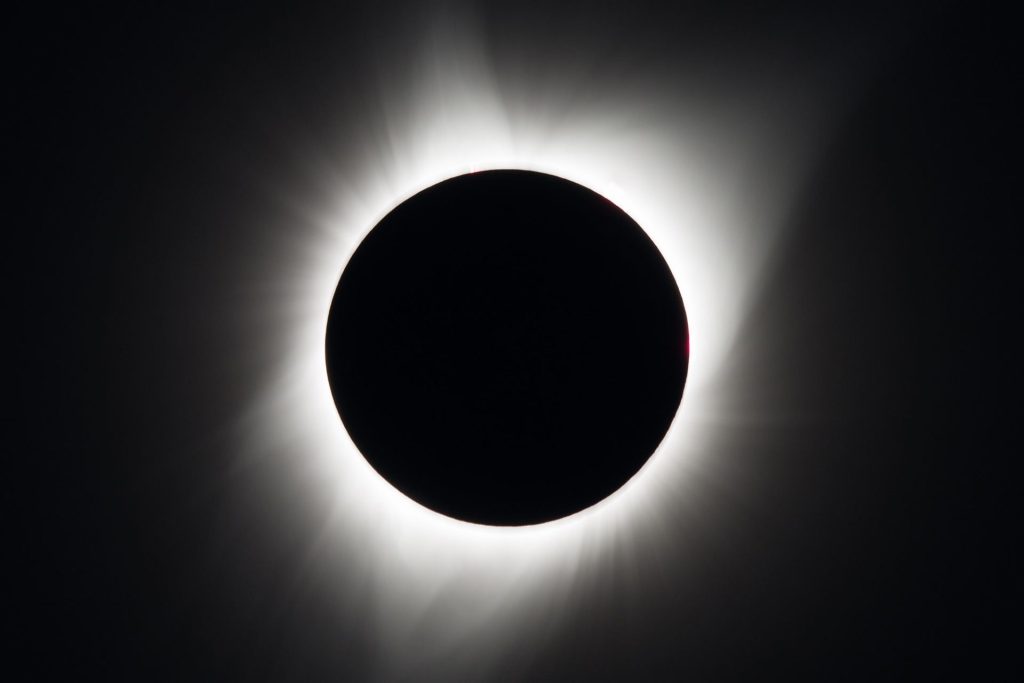
April 8, 2024, will be a busy day around the Dallas-Fort Worth region with the intersection of the sun and moon creating a total solar eclipse across a swath of Texas.

Brian Fridge MFA’11 has been preparing for the eclipse for months. A Dallas video artist and lecturer in the Harry W. Bass Jr. School of Arts, Humanities, and Technology at The University of Texas at Dallas, Fridge was commissioned last year to prepare an art project that is part of a national effort called “In the Path of Totality” to generate interest in the rare sight of a total solar eclipse in the United States.
Beginning at about 12:23 p.m. on April 8, North Texans will be able to experience a total solar eclipse, something that hasn’t been seen in this region since 1878 and won’t occur in Dallas-Fort Worth for 300 more years.
Fridge was commissioned by the Simons Foundation of New York to join artists from across portions of 13 states from Texas to Maine where the total eclipse will be visible. These artists are producing works representing their artistic interpretations of the phenomenon. A total eclipse occurs when the moon completely blocks light from the sun for several minutes, a celestial event called totality.
“In working on my film, it became like a collaboration with chance and nature, and things emerged that I would never have thought of,” Fridge said. “Sometimes what emerged was something that I could use in the film, and sometimes it wasn’t. But I was pleasantly surprised.”

Fridge is known for creating abstract still images and films in which he records natural processes produced on a tabletop in his home, like crystals formed by ice or what looks like the motion of whirling, milky liquids or a close-up of what could be the iris of an eye.
Fridge’s portion of “In the Path of Totality,” which he calls “View Finder,” comprises three parts — a six-minute multimedia film, eclipse images from the film enlarged on five billboards around Dallas and a publication with an essay written by Lucia Simek, deputy director of Dallas Contemporary. Fridge also worked with Dr. Mary Urquhart, a UT Dallas planetary scientist, to learn more about the science behind a total eclipse. Simons Foundation eclipse art projects are following a triangle concept in which three people partner to produce the work — the artist, a scientist and an arts curator.
“A project like this shows there are truly different ways of knowing,” said Urquhart, an associate professor and department head of science/mathematics education in the School of Natural Sciences and Mathematics. “There are different ways of expressing curiosity. Science is one path, and I think art is another. When they work synergistically, you can create something truly special.”
Using educational and science resources and images showing examples of total eclipses provided by Urquhart, Fridge re-creates in his film various stages and views of a solar eclipse that reflect his theme of a viewfinder.

Join a panel discussion March 26 about the upcoming total solar eclipse with UTD experts. For the latest eclipse news, events and information, along with safe-viewing tips and other resources, visit the UT Dallas eclipse website.
“In our discussions about my film, we talked about the metaphor of viewing the eclipse through a lens, or a viewfinder,” Fridge said. “I was thinking about what these events would look like from different perspectives and through different eyes. I wanted to show it as though looking through a window or a car windshield or even showing what an eclipse would look like on the surface of the moon.”
Fridge’s film premiered at Dallas Contemporary on March 10 and also will be shown March 28 at The Texas Theatre. Plans are in the works to show the film on the UT Dallas campus, too. Eclipse images from the film were displayed on billboards around Dallas.
Urquhart said she was excited to work with Fridge on his project because of the power of art to create emotional reactions to science topics, even if artworks like Fridge’s film are not exact illustrations of scientific subjects.
“His work is fundamentally an artistic vision that a scientist helped create,” Urquhart said. “The purpose is not to understand the eclipse. The purpose is to help us experience it and engage with it in a different way.”
